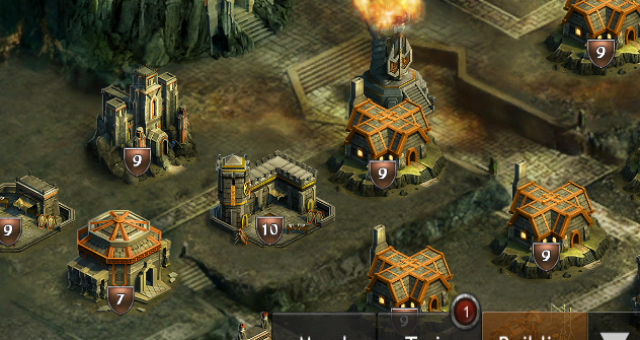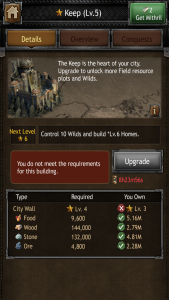
Hobbit: Kingdoms of Middle Earth – City Resource Guide
Since I have guides for 2nd and 3rd cities that have been useful, I figured it might be very helpful to have a Hobbit: Kingdoms of Middle Earth – City Resource Guide so you can plan out your cities better. And considering that having a 4th city in your kingdom is now possible, this will help you build your city to serve a specific function or fulfill a specific need. My earlier guides focused more on troops and relieving your more productive cities of the burden of maintaining those troops in order to maximize productivity. I didn’t specify which buildings and the number of each to have in each city because I was taking into consideration the different playing styles and goals of each player. Some might enjoy attacking other cities while others might enjoy playing the campaign mode more. This city resource guide will still take that into consideration but this will focus on the actual layout of the city including runecrafted buildings. As the description tells you when you select it, the Keep is the heart of your city, and it’s crucial to city planning because your Keep’s level determines how many available plots you have to build on. It also determines how many houses you can build and keep in mind that your population is essentially a resource too because you can have all your resource buildings maxed out but nothing will be produced if you don’t have a population. Your population is also crucial in determining how many troops you can train at one time and if you’re trying to train tier 4 troops then you’ll definitely need a good size population.
Now, a lvl 9 Keep gives you 31 city plots and 37 field plots in your first and second city. However after building all the essential buildings in the city (11 in your first city and 10 in all other cities) you’re left with 20 or 21 city plots available to build Houses or Barracks. And on your field map you can build any combination of Farms, Mines, Quarries and Lumber Mills to produce food, ore, stone, and wood, respectively. A lvl 10 Keep will give you a maximum of 40 field plots. Keep in mind (no pun intended) that you need a hobbit building crew in order to raise any building to lvl 10 so when you do get one it’s important to use it wisely as they’re not the easiest to get unless you purchase them. So considering you receive up to 5 extra field plots for using a hobbit building crew I recommend that you use your first one to upgrade your Keep. Third cities are slightly bigger so a lvl 9 Keep gives you 31 city plots and 40 field plots, and a lvl 10 Keep gives you 34 city plots and 43 field plots. So your third and fourth cities will be better for specialization.
To get the basics out of the way, you need food, wood, stone, and ore to produce everything, including troops, but the only maintenance required after production is food. Each tier has different maintenance requirements but the city you keep your troops in will have to produce enough food to maintain them in order to still be a productive city and not be in the red in terms of food production. If your city has no food you can’t produce or research anything. So here’s what produced by these resource buildings and the requirements if everything is at level 9 including your research:
| Building | No. of Workers | Production/Hour | Capacity |
|---|---|---|---|
Farm |
450 | 9000 | 450000 |
Lumber Mill |
450 | 9000 | 450000 |
Mine |
450 | 9000 | 450000 |
Quarry |
450 | 9000 | 450000 |
As you can see it’s all the same regardless of building type. Upgrading those buildings to lvl 10 just makes everything 550, 11000 and 550000 respectively. Runecrafted doesn’t give as big a bump each level as a lvl *10 building uses 825 workers and produces 8250/hr and 850,000 capacity. (Forge Runes can be found in the Through Mirkwood campaign at the 3rd boss). So here’s the most you can produce in your city for all combined resources:
| City | No. of Field Plots | Workers | Production/Hour |
|---|---|---|---|
1st |
37 | 16650 | 333000 |
2nd |
37 | 16650 | 333000 |
3rd |
40 | 18000 | 360000 |
So as you can see you’ll need a large population in order to maximize your production. It’s slightly higher for lvl 10 and runecrafted buildings but it should be clear now. So even for cities that you want to use to specialize in just producing resources and not training troops, it wouldn’t be beneficial to build all houses on your city plot because they’ll just be idle unless you raise taxes in the city to acquire more gold. Barracks are necessary to train troops and the number of barracks you have determines the number of different troop types you can have in your queue to train and the speed in which they’re trained. But you also need an idle population to train troops so how many houses do you need to have enough to reach maximum resource production? This table should help for lvl 9:
| City | No. of City Plots | Population/House | Max Population |
|---|---|---|---|
1st |
20 | 4500 | 90000 |
2nd |
21 | 4500 | 94500 |
3rd |
24 | 4500 | 108000 |
Clearly you won’t need to use every plot for houses to have enough workers as you’ll only need exactly 4 houses. So that gives you up to 20 plots to use for barracks and houses for the population needed to train troops. But you have to keep in mind that troops require hourly food maintenance so you will need at least one city capable of maintaining all your troops. And if you felt there weren’t enough tables in this post then you’re in luck. Here’s a summary of the requirements to train and maintain the different troop types and tiers:
| Tier | Population | Maintenance | Max # of Troops |
|---|---|---|---|
1st |
2 | 4 | 90000 |
2nd |
4 | 8 | 45000 |
3rd |
8 | 16 | 22500 |
4th |
24 | 24 | 15000 |
The population is the population required to produce one of those troops and the Max # of Troops is the amount of troops your city could maintain if every field plot in your 3rd city was a farm. So I can’t go through all the possibilities in this one post on how you can use this information to construct your city in any way you want but I will give an example of a balanced city producing each resource equally and what that will give you in terms of troop production and maintenance as well. You can tweak everything based on your desires. So if you do want a city that can maintain the max # of troops and only have farms in your field, then just keep in mind that you’ll have to transport all the other resources to that city or attack other cities. Any questions or suggestions let me know below
Balanced 3rd City Example:
- 10 Field plots for each resource (Farm, Lumber Mill, Mine, Quarry)
- 14 Houses (4 for workers and 10 to train troops and taxes)
- 10 Barracks (-19% Training Speed per lvl 9 Barracks)
So here’s what you get for that arrangement:
| Population | Production/hr | Max # of Troops | Training Speed Reduction |
|---|---|---|---|
63000 |
90000 | 5625 | 88% |
So you’ll be producing 90,000 for each resource per hour, the max number of tier 3 troops the city can support is 5,625 and it can train troops at 88% less time than base speed. So I usually have more farms than any other resource building so I can support more troops in each of my cities. So if you want to be able to support more troops without doing calculations just make sure you have more than 10 farms in your field.


1 comment
Pingback: Hobbit: Kingdoms of Middle-Earth - How to Get Gear - Hulking Reviewer